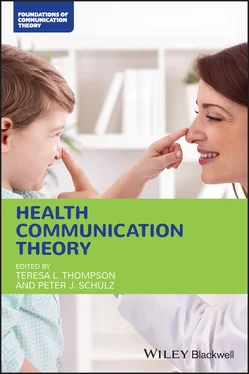70 Meppelink, C. S., Smit, E. G., Buurman, B. M., & van Weert, J. C. M. (2015). Should we be afraid of simple messages? The effects of text difficulty and illustrations in people with low or high health literacy. Health Communication, 30, 1181–1189.
71 Merz, J. (1983). A questionnaire for the measurement of psychological reactance. Diagnostics, 29, 75–72.
72 Miller, C. H., Burgoon, M., Grandpre, J. R., & Alvaro, E. M. (2006). Identifying principal risk factors for the initiation of adolescent smoking behaviors: The significance of psychological reactance. Health Communication, 19, 241–252. doi:10.1207/s15327027hc1903_6
73 Miller, C. H., & Quick, B. L. (2010). Sensation seeking and psychological reactance as health risk predictors for an emerging adult population. Health Communication, 25, 266–275. doi:10.1080/10410231003698945
74 Missotten, L. C., Luyckx, K., Branje, S., & Van Petegem, S. (2017). Adolescents’ conflict management styles with mothers: Longitudinal associations with parenting and reactance. Journal of Youth and Adolescence, 47, 260–274. doi:10.1007/s10964‐017‐0634‐3
75 Moriarty, S., Mitchell, N. D., Wells, W. D., Crawford, R., Brenan, L., & Spence‐Stone, R. (2014). Advertising: Principles and practice (3rd ed.). Melbourne, VIC, Australia: Pearson.
76 Morrison, K. A. (1997). Personality correlates of the five‐factor model for a sample of business owners/managers: Associations with scores on self‐monitoring, type a behavior, locus of control, and subjective well‐being. Psychological Reports, 80 (1), 255–272. doi:10.2466/pr0.1997.80.1.255
77 Nielsen‐Bohlman, L., Panzer, A., & Kindig, D. (2004). Health literacy: A prescription to end confusion. Washington, DC: National Academy of Sciences.
78 O'Cass, A. (2000). A psychometric evaluation of a revised version of the Lennox and Wolfe revised self‐monitoring scale. Psychology & Marketing, 17, 397–419.
79 Oh, I.‐S., Charlier, S. D., Mount, M. K., & Berry, C. M. (2013). The two faces of high self‐monitors: Chameleonic moderating effects of self‐monitoring on the relationships between personality traits and counterproductive work behaviors. Journal of Organizational Behavior, 35, 92–111. doi.org/10.1002/job.1856
80 O’Keefe, D. (2013). The elaboration likelihood model. In J. P. Dillard & L. Shen (Eds.), The Sage handbook of persuasion: Developments in theory and practice (pp. 137–149). Thousand Oaks, CA: Sage.
81 Paasche‐Orlow, M. K., & Wolf, M. S. (2007). The causal pathways linking health literacy to health outcomes. American Journal of Health Behavior, 31, S19–26.
82 Palmgreen, P., Donohew, L., Lorch, E. P., Hoyle, R., & Stephenson, M. T. (2001). Television campaigns and adolescent marijuana use: Tests of sensation‐seeking targeting. American Journal of Public Health, 91, 292–296.
83 Perloff, R. M. (2003). The dynamics of persuasion: Communication and attitudes in the 21st century (2nd ed.). Mahwah, NJ: Erlbaum.
84 Petty, R. E., Briñol, P., Teeny, J., & Horcajo, J. (2017). The elaboration likelihood model. In B. Jackson, J. Dimmock, & J. Compton (Eds.) Persuasion and communication in sport, exercise, and physical activity (pp. 22–37). New York, NY: Routledge.
85 Petty, R. E., & Cacioppo, J. T. (1979). Issue involvement can increase or decrease persuasion byenhancing message‐relevant cognitive responses. Journal of Personality and SocialPsychology, 37, 1915–1926. doi:10.1037/0022‐3514.37.10.1915
86 Petty, R. E., & Cacioppo, J. T. (1986). Communication and persuasion: Central and peripheral routes to attitude change. New York: Springer‐Verlag.
87 Pfau, M., Banas, J., Semmler, S. M., Deatrick, L., Lane, L., Mason, A., … Underhill, J. (2010). Role and impact of involvement and enhanced threat in resistance. Communication Quarterly, 58, 1–18. doi:10.1080/01463370903520307
88 Pleasant, A., Cabe, J., Patel, K., Cosenza, J., & Carmona. R. (2015). Health literacy research and practice: A needed paradigm shift. Health Communication, 30(12), 1176–1180.
89 Pleasant, A., McKinney, J., & R. V. Rikard. (2011). Health literacy measurement: A proposed research agenda. Journal of Health Communication, 16, 11–21.
90 Quick, B. L., Bates, B. R., & Quinlan, M. R. (2009). The utility of anger in promoting clean indoor air policies. Health Communication, 24, 548–561. doi:10.1080/10410230903104939
91 Quick, B. L., & Heiss, S. N. (2009). An investigation of value‐, impression‐, and outcome‐relevant involvement on attitudes, purchase intentions, and information seeking. Communication Studies, 60, 253–267. doi:10.1080/10510970902956008
92 Quick, B. L., Shen, L., & Dillard, J. P. (2013). Reactance theory and persuasion. In J. P. Dillard & L. Shen (Eds.), The Sage handbook of persuasion: Developments in theory and practice (pp. 167–183). Thousand Oaks, CA: Sage.
93 Quick, B. L., & Stephenson, M. T. (2008). Examining the role of trait reactance and sensation seeking on perceived threat, state reactance, and reactance restoration. Human Communication Research, 34, 448–476. doi:10.1111/j.1468‐2958.2008.00328.x
94 Richards, S., & Nelson, C. (2012). Problematic parental drinking and health: Investigating differences in adult children of alcoholic status, health locus of control, and health self‐efficacy. Journal of Communication in Healthcare: Strategies, Media and Engagement in Global Health, 5, 84–90. doi:10.1179/1753807612Y.0000000006
95 Rotter, J. B. (1966). Generalized expectancies for internal versus external control of reinforcement. Psychological Monographs: General and Applied, 80, 1–28.
96 Seibel, C. A., & Dowd, E. T. (2001). Personality characteristics associated with psychological reactance. Journal of Clinical Psychology, 57, 963–969. doi:10.1002/jclp.1062
97 Shao, W., Grace, D., & Ross, M. (2019). Consumer motivation and luxury consumption: Testing moderating effects. Journal of Retailing and Consumer Services, 46, 33–44. doi:10.1016/j.jretconser.2018.10.003
98 Shavitt, S., Lowrey, T. M., & Han, S.‐P. (1992). Attitude functions in advertising: The interactive role of products and self‐monitoring. Journal of Consumer Psychology, 1, 337–364. doi:10.1016/s1057‐7408(08)80059‐9
99 Shen, L., & Dillard, J. P. (2009). Message frames interact with motivational systems to determine depth of message processing. Health Communication, 24, 504–514. doi:10.1080/10410230903104897
100 Shen, L., & Mercer Kollar, L. M. (2015). Testing moderators of message framing effect: A motivational approach. Communication Research, 42, 626–648. doi:10.1177/0093650213493924
101 Sherif, M., & Cantril, H. (1947). The psychology of ego‐involvements: Social attitudes and identifications. New York, NY: Wiley.
102 Sherif, M., & Hovland, C. I. (1961). Social judgment: Assimilation and contrast effects in communication and attitude change. New Haven, CN: Yale University Press.
103 Sherif, C. W., Sherif, M., & Nebergall, R. E. (1965). Attitude and attitude change: The social judgment‐involvement approach. Philadelphia, PA: Saunders.
104 Slater, M. D. (1995). Choosing audience segmentation strategies and methods for communication. In E. W. Maibach & R. Parrott (Eds.), Designing health messages: Approaches from communication theory and public health practice (pp. 186–198). Thousand Oaks, CA: Sage.
105 Slater, M. D. (1996). Theory and method in health audience segmentation. Journal of Health Communication, 1, 267–284. doi:10.1080/108107396128059
106 Smith, C. V., Lair, E. C., & O’Brien, S. M. (2019). Purposely stoic, accidentally alone? Self‐monitoring moderates the relationship between emotion suppression and loneliness. Personality and Individual Differences, 149, 286–290. doi:10.1016/j.paid.2019.06.012
107 Snyder, M. (1974). Self‐monitoring of expressive behavior. Journal of Personality and Social Psychology, 30, 526–537. doi:10.1037/h0037039
Читать дальше












